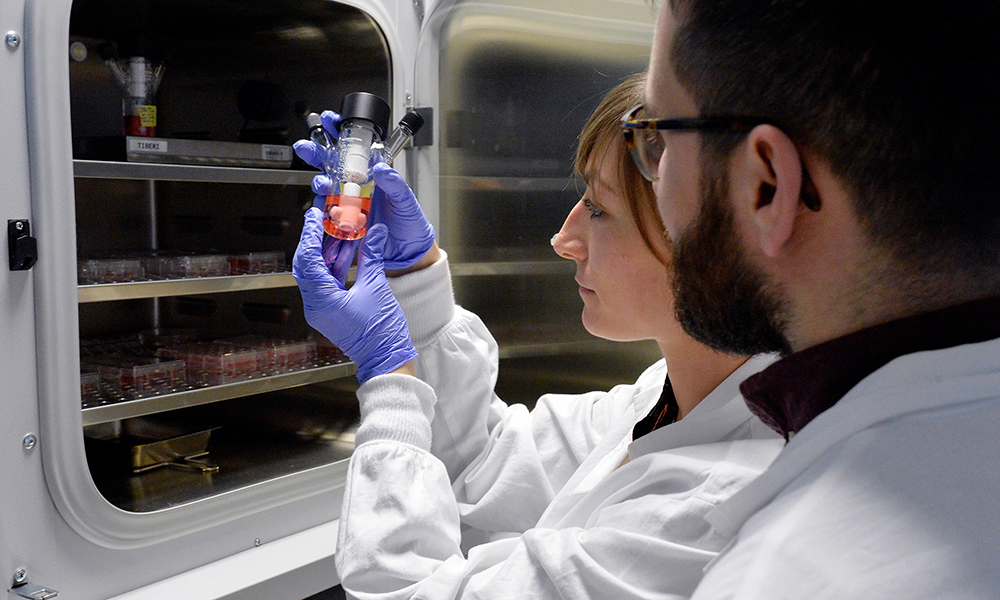
新冠病毒會(huì)對(duì)人類大腦造成什么影響,?
在發(fā)表于《分子精神病學(xué)》(Molecular Psychiatry)上的一項(xiàng)新研究中,來自瑞典和美國波士頓一家哈佛大學(xué)附屬醫(yī)院的研究人員通過構(gòu)建“類腦器官”(針頭大小的微型大腦),,并使其感染新冠病毒,,試圖找出上述問題的答案。
實(shí)驗(yàn)結(jié)果給出了很多解釋:在發(fā)病過程中,,突觸(腦細(xì)胞之間相互連接,、并借以傳遞信息的部位)被“超額”消滅——“多于你在正常大腦中看到的數(shù)量”,學(xué)術(shù)新聞網(wǎng)站The Conversation上10月27日的一篇文章寫道,。
在一個(gè)被稱為“修剪”的過程中,,正常大腦會(huì)清除一定數(shù)量不活躍的、不再需要的突觸,,為新的突觸創(chuàng)造空間,。但根據(jù)文章作者的說法,感染新冠病毒后的微型大腦出現(xiàn)了不必要的過度清理,,程度類似于精神分裂癥,、阿爾茨海默癥和帕金森病等神經(jīng)疾病。
研究人員觀察到的現(xiàn)象或許可以解釋為什么許多長(zhǎng)期新冠患者出現(xiàn)了神經(jīng)系統(tǒng)癥狀,,以及為什么感染新冠病毒似乎加劇了罹患某些神經(jīng)疾病的風(fēng)險(xiǎn),。
已經(jīng)確定的是,感染過新冠病毒的人出現(xiàn)中風(fēng),、記憶問題,、抑郁、焦慮和偏頭痛等并發(fā)癥的風(fēng)險(xiǎn)更高,?!堵圆≈委熯M(jìn)展》(Therapeutic Advances in Chronic Disease)今年2月的一篇文章稱,超過三分之一的新冠患者出現(xiàn)了神經(jīng)系統(tǒng)癥狀。
眾所周知,,一些長(zhǎng)期新冠患者會(huì)出現(xiàn)神經(jīng)系統(tǒng)癥狀,,例如顫抖、運(yùn)動(dòng)障礙,、痙攣,、癲癇、聽力和視力問題,、平衡和協(xié)調(diào)問題,,以及其他類似帕金森病的癥狀。長(zhǎng)期新冠最常見的神經(jīng)癥狀包括“腦霧”,、頭痛,、意識(shí)模糊、睡眠障礙,、情緒障礙,、嗅覺或味覺問題,以及自主神經(jīng)異常,,即自主神經(jīng)系統(tǒng)紊亂,,可能出現(xiàn)昏厥、站立時(shí)血壓下降,、心率過快或其他與軀體非自主功能有關(guān)的問題,。
這項(xiàng)新研究的作者提醒道,實(shí)驗(yàn)中的微型大腦非常小,,可能更像胎兒的大腦,,而非成年人的大腦。不過,,他們說,,部分對(duì)新冠死亡個(gè)體的研究以及對(duì)幸存者的成像研究顯示,新冠感染者腦內(nèi)神經(jīng)元死亡,、大腦灰質(zhì)厚度減少,,這是突觸減少的信號(hào)。
根據(jù)美國人口普查局(U.S. Census Bureau)在今年夏天收集的數(shù)據(jù),,近20%感染過新冠病毒的美國成年人——估計(jì)有5,000萬——稱在感染轉(zhuǎn)陰后出現(xiàn)了長(zhǎng)期新冠癥狀,。
長(zhǎng)期新冠的大致定義是,在一開始的感染轉(zhuǎn)陰后很長(zhǎng)時(shí)間內(nèi)仍然持續(xù)或新出現(xiàn)的癥狀,,但目前還沒有得到廣泛認(rèn)可的統(tǒng)一定義,。
許多專家認(rèn)為,長(zhǎng)期新冠的最佳定義為,,在感染新冠病毒后出現(xiàn)的一種類似慢性疲勞綜合征的病癥,類似于感染皰疹、萊姆病甚至埃博拉等其他病毒后可能出現(xiàn)的綜合征,。他們說,,感染新冠病毒后的其他并發(fā)癥,比如重癥監(jiān)護(hù)后綜合征,,就不應(yīng)該被歸類為長(zhǎng)期新冠,。(財(cái)富中文網(wǎng))
譯者;Agatha
新冠病毒會(huì)對(duì)人類大腦造成什么影響,?
在發(fā)表于《分子精神病學(xué)》(Molecular Psychiatry)上的一項(xiàng)新研究中,,來自瑞典和美國波士頓一家哈佛大學(xué)附屬醫(yī)院的研究人員通過構(gòu)建“類腦器官”(針頭大小的微型大腦),并使其感染新冠病毒,,試圖找出上述問題的答案,。
實(shí)驗(yàn)結(jié)果給出了很多解釋:在發(fā)病過程中,突觸(腦細(xì)胞之間相互連接,、并借以傳遞信息的部位)被“超額”消滅——“多于你在正常大腦中看到的數(shù)量”,,學(xué)術(shù)新聞網(wǎng)站The Conversation上10月27日的一篇文章寫道。
在一個(gè)被稱為“修剪”的過程中,,正常大腦會(huì)清除一定數(shù)量不活躍的,、不再需要的突觸,為新的突觸創(chuàng)造空間,。但根據(jù)文章作者的說法,,感染新冠病毒后的微型大腦出現(xiàn)了不必要的過度清理,程度類似于精神分裂癥,、阿爾茨海默癥和帕金森病等神經(jīng)疾病,。
研究人員觀察到的現(xiàn)象或許可以解釋為什么許多長(zhǎng)期新冠患者出現(xiàn)了神經(jīng)系統(tǒng)癥狀,以及為什么感染新冠病毒似乎加劇了罹患某些神經(jīng)疾病的風(fēng)險(xiǎn),。
已經(jīng)確定的是,,感染過新冠病毒的人出現(xiàn)中風(fēng)、記憶問題,、抑郁,、焦慮和偏頭痛等并發(fā)癥的風(fēng)險(xiǎn)更高?!堵圆≈委熯M(jìn)展》(Therapeutic Advances in Chronic Disease)今年2月的一篇文章稱,,超過三分之一的新冠患者出現(xiàn)了神經(jīng)系統(tǒng)癥狀。
眾所周知,,一些長(zhǎng)期新冠患者會(huì)出現(xiàn)神經(jīng)系統(tǒng)癥狀,,例如顫抖、運(yùn)動(dòng)障礙,、痙攣,、癲癇、聽力和視力問題、平衡和協(xié)調(diào)問題,,以及其他類似帕金森病的癥狀,。長(zhǎng)期新冠最常見的神經(jīng)癥狀包括“腦霧”、頭痛,、意識(shí)模糊,、睡眠障礙、情緒障礙,、嗅覺或味覺問題,,以及自主神經(jīng)異常,即自主神經(jīng)系統(tǒng)紊亂,,可能出現(xiàn)昏厥,、站立時(shí)血壓下降、心率過快或其他與軀體非自主功能有關(guān)的問題,。
這項(xiàng)新研究的作者提醒道,,實(shí)驗(yàn)中的微型大腦非常小,可能更像胎兒的大腦,,而非成年人的大腦,。不過,他們說,,部分對(duì)新冠死亡個(gè)體的研究以及對(duì)幸存者的成像研究顯示,,新冠感染者腦內(nèi)神經(jīng)元死亡、大腦灰質(zhì)厚度減少,,這是突觸減少的信號(hào),。
根據(jù)美國人口普查局(U.S. Census Bureau)在今年夏天收集的數(shù)據(jù),近20%感染過新冠病毒的美國成年人——估計(jì)有5,000萬——稱在感染轉(zhuǎn)陰后出現(xiàn)了長(zhǎng)期新冠癥狀,。
長(zhǎng)期新冠的大致定義是,,在一開始的感染轉(zhuǎn)陰后很長(zhǎng)時(shí)間內(nèi)仍然持續(xù)或新出現(xiàn)的癥狀,但目前還沒有得到廣泛認(rèn)可的統(tǒng)一定義,。
許多專家認(rèn)為,,長(zhǎng)期新冠的最佳定義為,在感染新冠病毒后出現(xiàn)的一種類似慢性疲勞綜合征的病癥,,類似于感染皰疹,、萊姆病甚至埃博拉等其他病毒后可能出現(xiàn)的綜合征。他們說,,感染新冠病毒后的其他并發(fā)癥,,比如重癥監(jiān)護(hù)后綜合征,就不應(yīng)該被歸類為長(zhǎng)期新冠,。(財(cái)富中文網(wǎng))
譯者,;Agatha
Just what is COVID capable of doing to the human brain?
In a new study published in Molecular Psychiatry, researchers from Sweden and a Harvard-affiliated hospital in Boston tried to find out by creating “brain organoids,” or miniature brains about the size of a pinhead, and infected them with COVID.
What they saw explained a lot: An “excessive number” of synapses, or connections between brain cells that allow them to communicate, were eliminated during the course of the disease—“more than you would expect to see in a normal brain,” the authors wrote in an Oct. 27 article on academic news site The Conversation.
In a process known as “pruning,” normal brains get rid of a certain amount of inactive synapses when they’re no longer needed, to make way for new ones. But the infected mini brains showed unnecessary and inordinate levels of the clean-up process, similar to the level seen in neurological disorders like schizophrenia, Alzheimer’s, and Parkinson’s disease, according to the authors.
What researchers witnessed may explain why many Long COVID sufferers report neurological symptoms, and why COVID seems to increase the risk of developing some neurological disorders.
It’s well established that those who’ve had COVID are at an increased risk for complications like stroke, memory problems, depression, anxiety, and migraines. More than a third of those who’ve had COVID report neurologic symptoms, according to a February article in Therapeutic Advances in Chronic Disease.
And it’s well known that some Long COVID sufferers experience neurologic symptoms like tremors, issues with movement, involuntary muscle contractions, seizures, hearing and vision issues, balance and coordination problems, and other Parkinson’s disease-like symptoms. The most frequent neurological symptoms of Long COVID include “brain fog,” headache, confusion, sleep disorders, mood disorders, issues with smell or taste, and dysautonomia, a disorder of the autonomic nervous system that can involve fainting, drops in blood pressure when standing, rapid heart rate, and other issues with involuntary bodily functions.
Authors of the new study caution that because the mini brains they created are so small, they may resemble the brain of a fetus more than that of an adult. Still, some studies of individuals who’ve died from COVID, in addition to imaging studies of those who’ve survived it, report the death of neurons and a reduction in the thickness of gray matter in the brain, signs of synapse loss, they say.
Nearly 20% of American adults who’ve had COVID—an estimated 50 million—report having Long COVID symptoms after their infection resolves, according to data collected by the U.S. Census Bureau this summer.
Long COVID is roughly defined as symptoms that persist or appear long after the initial COVID infection is gone, but a consensus definition has not yet been broadly accepted.
Many experts contend that long COVID is best defined as a chronic-fatigue-syndrome-like condition that develops after COVID illness, similar to other post-viral syndromes like those that can occur after infection with herpes, Lyme disease, and even Ebola. Other post-COVID complications like post-intensive-care syndrome should not be defined as long COVID, they say.






